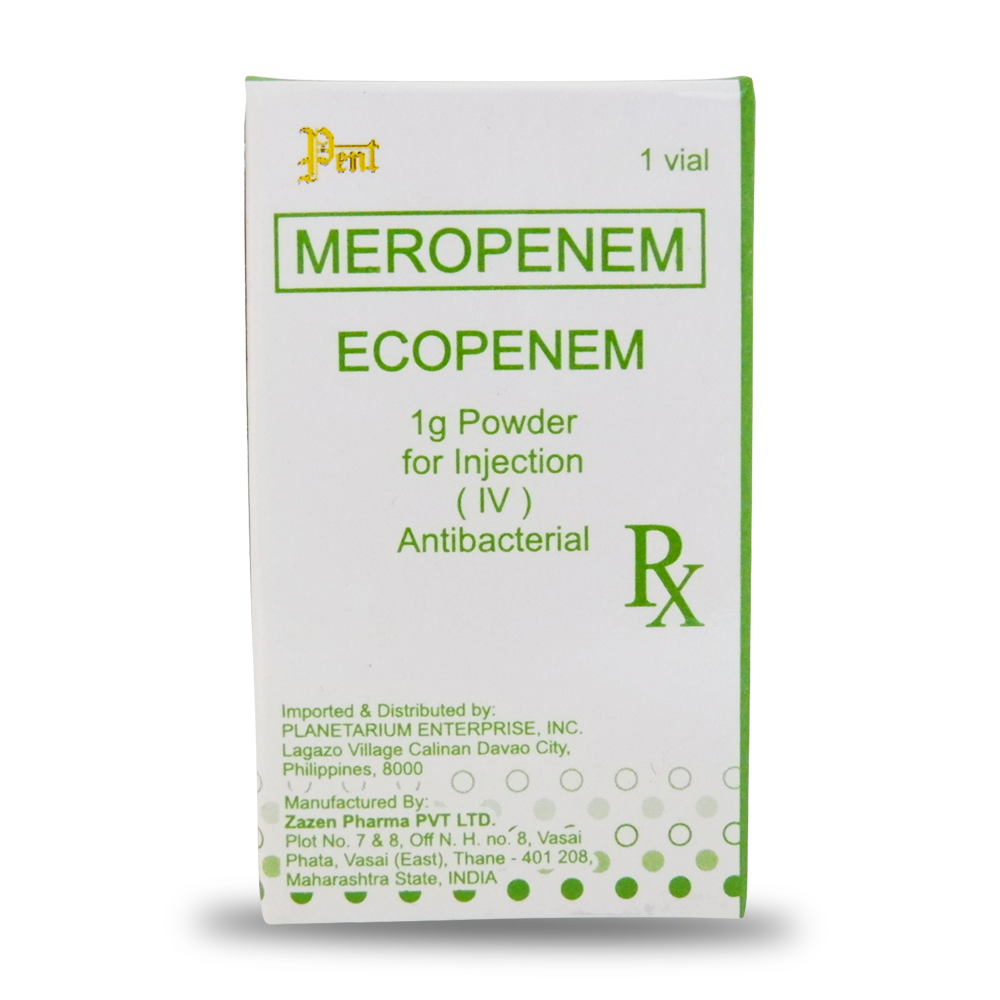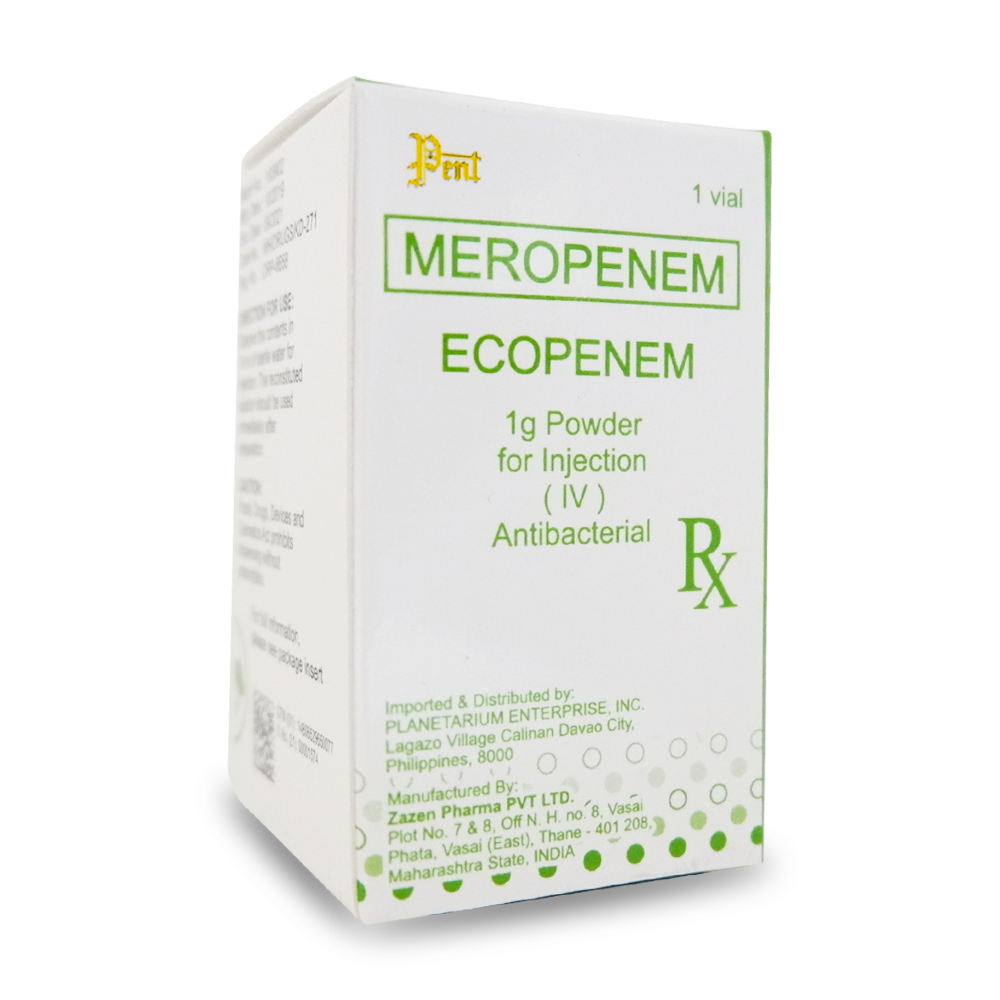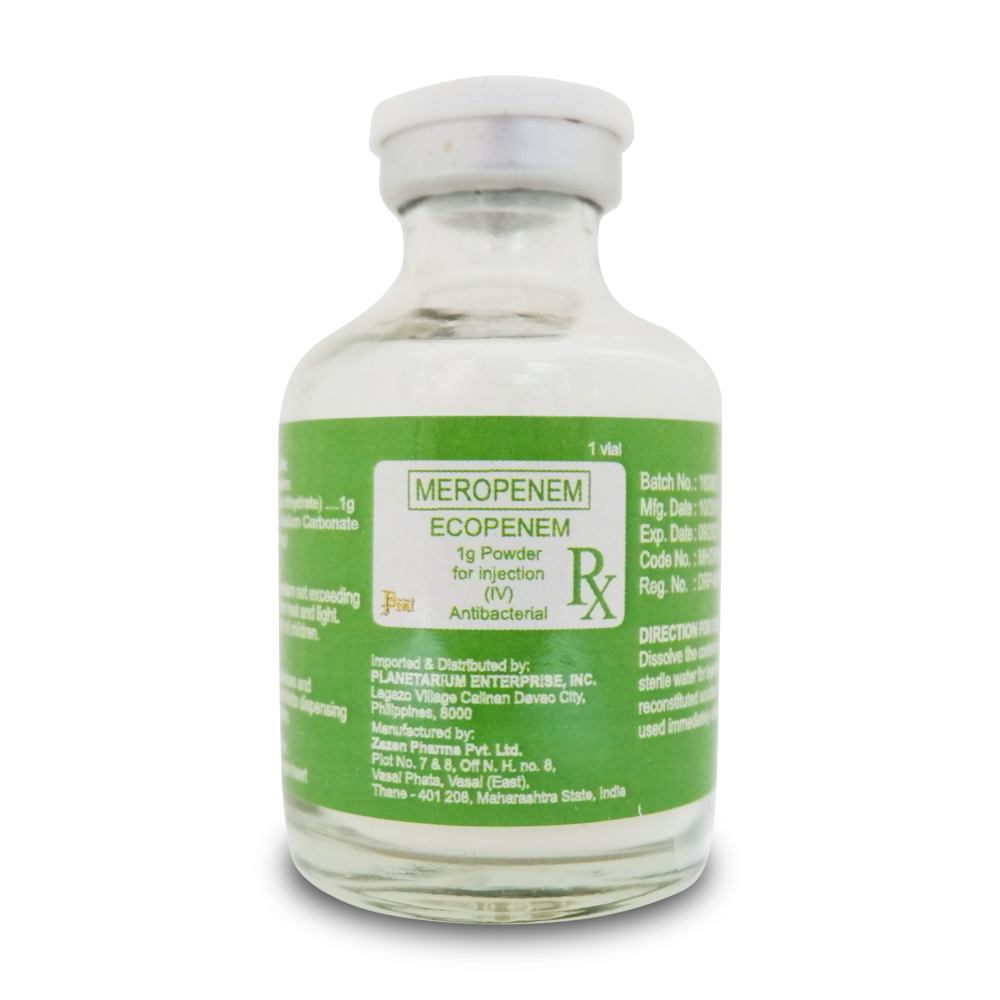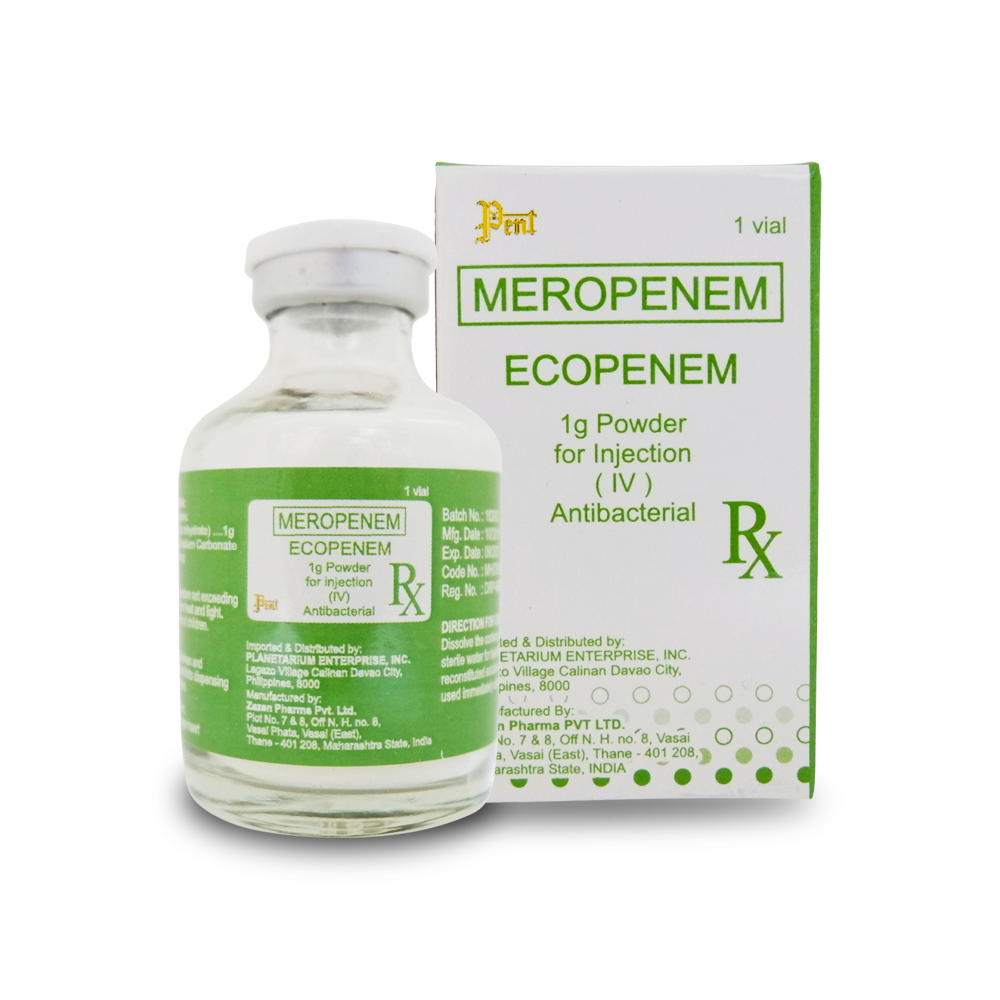



Generic Name: MEROPENEM
Ecopenem
1g Powder for Injection (IV)
ANTIBACTERIAL
Formulation:
Each vial contains:
Meropenem (as trihydrate) USP ………. 1 g
Also contains Sodium Carbonate (Sodium 90.2mg)
Direction For Use:
Dissolve the contents in 10 ml of sterile water for injection. The reconstituted solution should be used immediately after preparation.
Indications and Usage:
To reduce the development of drug resistant bacteria and maintain its effectiveness and other antibacterial drugs, it should only be used to treat or prevent infections that are proven or strongly suspected to be caused by susceptible bacteria.
It is useful as presumptive therapy in the indicated condition (e.g. intra-abdominal infections) prior to the identification of the causative organisms because of its broad spectrum of bactericidal activity.
Dosage and Administration:
Adult Patients
The recommended dose of 1 g given every 8 hours for intra-abdominal infections. When treating complicated skin and skin structure infections caused by P. aeruginosa, a dose of 1 g every hours is recommended. It should be administered by intravenous infusion over approximately 15 to 30 minutes. Doses of 1 g may also be administered as an intravenous bolus injection (5 to 20 ml) over approximately 3-5 minutes.
Use in Adult Patients with Renal Impairment
Dosage should be reduced in patients with creatinine clearance of SO mUmin or less. (See dosing table below.)
When only serum creatinine is available, the following formula (Cockcroft and Gault equation) may be used to estimate creatinine clearance.
Males: Creatinine Clearance (mUmin) = Weight (kg) x (140 – age)
72 x serum creatinine (mg/dl) Females: 0.85 x above value
Recommended Meropenem I.V Dosage Schedule for Adult Patients with Renal Impairment
There is inadequate information regarding the use of Meropenem I.V. in patients on hemodialysis or peritoneal dialysis.
Use in Pediatric Patient (months only)
For pediatric patients from 3 months of age and older, the Meropenem I.V. dose is 10, 20 or 40 mg/kg every 8 hours (maximum dose is 2 g every 8 hours), depending on type of infection (complicated skin and skin structure, intra-abdominal or meningitis). (See dosing table below). Pediatric patients weighing over 50 kg should be administered by Meropenem I.V. at a dose of 500 mg every 8 hours for complicated skin and skin structure infections, 1 g every 8 hours for intra-abdominal infections and 2 g every 8 hours for meningitis. Meropenem I.V. should be given as intravenous infusion over approximately 15 to 30 minutes or as an intravenous bolus injection (5 to 20 ml) over approximately 3-5 minutes.
There is limited safety data available to support the administration of a 40 mg/kg (up to maximum of 2 g) bolus dose. Recommended Meropenem I.V.
Dosage Schedule for Pediatric Patients with Normal Renal Function
Type of Infection Dose (mg/kg) Up to a Maximum Dose Dosing Interval Every 8 hours
Complicated skin and skin structure 10 500 mg Every 8 hours
Intra-abdominal 20 1 g Every 8 hours
Meningitis 40 2g Every 8 hours
Adverse Effects and Precautions:
Most common adverse effects are headache, nausea, constipation, diarrhea, anemia, vomiting and rash.
Pharmacokinetics:
Plasma Concentrations
At the end of a 30 minutes intravenous infusion of a single dose of Meropenem I.V. in healthy volunteers, mean peak plasma concentrations are approximately 23 mcg/ml (range 14-26) for the 500 mg dose and 49 mcg/ml (range 39-58) for the 1 g dose. A 5 minute intravenous bolus injection in healthy volunteers results in mean peak plasma concentrations of approximately 45 mcg/ml (range 18-65) for the 500 mg dose and 112 mcg/ml (range 83-140) for the 1 g dose.
Following intravenous doses of 500 mg, mean plasma concentrations of Meropenem usually decline to approximately 1 mcg/ml at 6 hours after administration.
No accumulation of Meropenem in plasma was observed with regimens using 500 mg administered every 8 hours or 1 g administered every 6 hours in healthy volunteers with normal renal function.
Distribution
The plasma protein binding of Meropenem is approximately 2%.
Meropenem penetrates well into most body fluids and tissues including cerebrospinal fluid, achieving concentrations matching or exceeding those required to inhibit most susceptible bacteria. After a single intravenous dose of Meropenem I.V., the highest mean concentrations were found in tissues and fluids at 1 hour (0.5 to 1.5 hours) after the start of infusion, except where indicated in the tissues and fluids.
Drug Interactions
Probenecid
Probenecid competes with Meropenem for active tubular secretion, resulting in increased in plasma concentrations. Co-adminis tration of probenecid is not recommended.
Valproic Acid
Case reports in the literature have shown that co-administration of carbapenems, including Meropenem, to patients receiving valproic acid or divalproex sodium results in a reduction in valproic acid concentrations. The valproic acid concentrations may drop below the therapeutic range as a result of this interaction, therefore increasing the risk of breakthrough seizures. Although the mechanism of this interaction is unknown, data from in-vitro and animal studies suggest that carbapenems may inhibit the hydrolysis of valproic acid-s glucuronide metabolite (VPA-g) back to valproic acid, thus decreasing in serum concentrations of valproic acid.
Availability:
Glass vial (box of l’s)
Caution:
Foods, Drugs, Devices and Cosmetics Act prohibits dispensing without prescription.
Storage Condition:
Store at a temperature not exceeding 3o0c. Protect from heat and light.
Keep out of reach of children.
For suspected adverse drug reaction, report to the FDA: www.fda.gov.ph
location_on Lagazo Village, Calinan, Davao City
local_phone (082) 299 1768
phone_android +63 917 301 4186